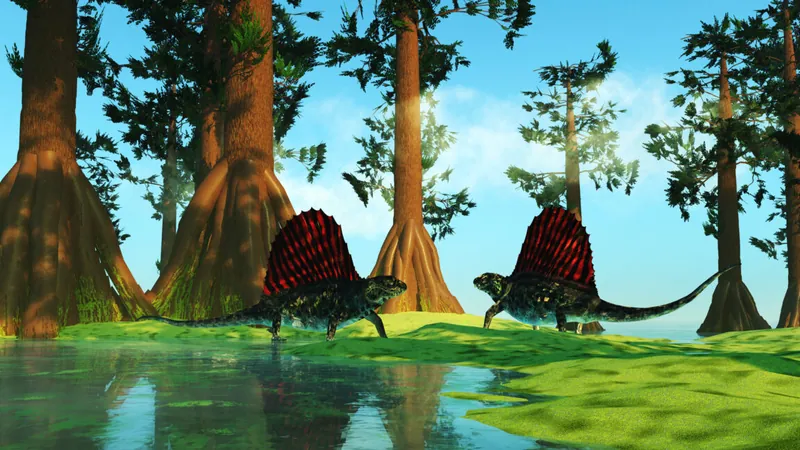
Unveiling Earth's Secrets: How Life Throve Amid the Great Dying
2025-03-18
Author: Chun
Unveiling Earth's Secrets: How Life Throve Amid the Great Dying
Around 252 million years ago, the End-Permian Mass Extinction, often dubbed the Great Dying, obliterated roughly 96% of marine species. But what about life on land? Extensive research now indicates that terrestrial ecosystems endured much better than previously thought during this catastrophic event.
In a groundbreaking study, scientists from the Nanjing Institute of Geology and Paleontology (NIGPAS) revealed the remarkable existence of refugiums—sheltered oases where flora and fauna persisted against the odds during this daunting period. Led by the esteemed paleontologist Feng Liu, the NIGPAS team uncovered vital evidence that these oases played a critical role in the survival and quick recovery of life following the extinction, which lasted around 200,000 years.
The analysis took them to the Turpan-Hami Basin in Xinjiang, China, where fossilized tree trunks and fern remnants were discovered intact in what was once lush soil. This remarkable preservation illustrates that life flourished in these refugiums, starkly contrasting the devastation seen in oceans.
Intriguingly, the research found preserved pollen grains and spores, providing insights into the rich diversity of plant life that thrived even amid chaos. These findings suggest that despite the severe challenges posed by the great extinction, the conditions in these refugiums were just right—akin to an oasis rich in food and water, offering sanctuary to earth’s surviving life forms.
The team meticulously examined rock layers dating back to before, during, and after the mass extinction. With accurate zircon dating, it emerged that many plant species had flourished in these regions up to 160,000 years before the catastrophic event, managing to endure well into the aftermath—up to 210,000 years later. Although some early species faced extinction, the majority proved resilient, with only about 21% of plant species permanently disappearing.
The fossils unearthed revealed a thriving ecosystem that suggested an environment conducive to supporting life, including water sources for terrestrial animals. The presence of fossilized plants, particularly those that thrive near lakes, implied a region rich in water and surrounded by flourishing forests of conifers and ancient ferns.
Research indicates that the regional climate prior to the mass extinction was likely humid, allowing for a verdant ecosystem that weathered dry spells without total obliteration. Remarkably, while some species perished, notably conifers and pteridosperms—ancestors of ferns—demonstrated exceptional drought resilience, allowing them to survive the transformation.
As time progressed, younger rock strata revealed an increase in abundant pollen and spores indicative of a rebounding climate, suggesting that habitats returned to a more hospitable, subhumid state.
The discovery was further corroborated by fossils of creatures that clearly thrived in this sanctuary. Herbivores like Lystrosaurus, resembling walruses with limbs, and carnivorous chroniosuchians, giant lizard-like beasts that feasted on smaller animals, found refuge in this life-sustaining oasis.
Ultimately, both plant and animal life underwent a magnificent resurgence less than 75,000 years after the Great Dying. The findings underscore an enduring truth: despite the trials of extinction, life is remarkably resilient, always finding a way to flourish again. As new discoveries continue to shed light on prehistoric survival, we are reminded of the tenacity of life on Earth against all odds.
This research, published in Science Advances, opens up new avenues in understanding the resilience of ecosystems and the potential ways current environmental crises might similarly be navigated.
Stay tuned for more developments as scientists continue to explore our planet’s ancient past!




 Brasil (PT)
Brasil (PT)
 Canada (EN)
Canada (EN)
 Chile (ES)
Chile (ES)
 Česko (CS)
Česko (CS)
 대한민국 (KO)
대한민국 (KO)
 España (ES)
España (ES)
 France (FR)
France (FR)
 Hong Kong (EN)
Hong Kong (EN)
 Italia (IT)
Italia (IT)
 日本 (JA)
日本 (JA)
 Magyarország (HU)
Magyarország (HU)
 Norge (NO)
Norge (NO)
 Polska (PL)
Polska (PL)
 Schweiz (DE)
Schweiz (DE)
 Singapore (EN)
Singapore (EN)
 Sverige (SV)
Sverige (SV)
 Suomi (FI)
Suomi (FI)
 Türkiye (TR)
Türkiye (TR)
 الإمارات العربية المتحدة (AR)
الإمارات العربية المتحدة (AR)